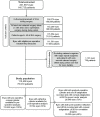Distribution of preoperative and postoperative astigmatism in a large population of patients undergoing cataract surgery in the UK
- PMID: 30190365
- PMCID: PMC6591741
- DOI: 10.1136/bjophthalmol-2018-312025
Distribution of preoperative and postoperative astigmatism in a large population of patients undergoing cataract surgery in the UK
Abstract
Purpose: To assess the prevalence and severity of preoperative and postoperative astigmatism in patients with cataract in the UK.
Setting: Data from 8 UK National Health Service ophthalmology clinics using MediSoft electronic medical records (EMRs).
Design: Retrospective cohort study.
Methods: Eyes from patients aged ≥65 years undergoing cataract surgery were analysed. For all eyes, preoperative (corneal) astigmatism was evaluated using the most recent keratometry measure within 2 years prior to surgery. For eyes receiving standard monofocal intraocular lens (IOLs), postoperative refractive astigmatism was evaluated using the most recent refraction measure within 2-12 months postsurgery. A power vector analysis compared changes in the astigmatic 2-dimensional vector (J0, J45) before and after surgery, for the subgroup of eyes with both preoperative and postoperative astigmatism measurements. Visual acuity was also assessed preoperatively and postoperatively.
Results: Eligible eyes included in the analysis were 110 468. Of these, 78% (n=85 650) had preoperative (corneal) astigmatism ≥0.5 dioptres (D), 42% (n=46 003) ≥1.0 D, 21% (n=22 899) ≥1.5 D and 11% (n=11 651) ≥2.0 D. After surgery, the refraction cylinder was available for 39 744 (36%) eyes receiving standard monofocal IOLs, of which 90% (n=35 907) had postoperative astigmatism ≥0.5 D and 58% (n=22 886) ≥1.0 D. Visual acuity tended to worsen postoperatively with increased astigmatism (ρ=-0.44, P<0.01).
Conclusions: There is a significant burden of preoperative astigmatism in the UK cataract population. The available refraction data indicate that this burden is not reduced after surgery with implantation of standard monofocal IOLs. Measures should be taken to improve visual outcomes of patients with astigmatic cataract by simultaneously correcting astigmatism during cataract surgery.
Keywords: angle; epidemiology; treatment other; vision.
© Author(s) (or their employer(s)) 2019. Re-use permitted under CC BY-NC. No commercial re-use. See rights and permissions. Published by BMJ.
Conflict of interest statement
Competing interests: IQVIA received funding from Alcon Laboratories, Inc to conduct this study. ACD and DFA declare no competing interests. MD and MSK were employees of Alcon Laboratories Inc at the time of research. FE and CPV are employees of Alcon Management SA. CM and LZ are employees of IQVIA.
Figures






References
-
- Donachie J, Sparrow JM, Johnston RL. 2016Year 1 annual report – piloting of thenational ophthalmology database audit methodology national ophthalmology database audit https://www.nodaudit.org.uk/u/docs/20/thsumcnchv/NOD%20Audit%20Annual%20... (accessed 24 Apr 2017).
-
- The Royal College of Ophthalmologists 2010Cataract surgery guidelines. London https://www.rcophth.ac.uk/wp-content/uploads/2014/12/2010-SCI-069-Catara... (accessed 13 Dec 2016).
-
- Wilkins MR, Allan B, Rubin G. Moorfields IOL Study Group MIS. Spectacle use after routine cataract surgery. Br J Ophthalmol 2009;93:1307–12. - PubMed
Publication types
MeSH terms
LinkOut - more resources
Full Text Sources
Other Literature Sources
Medical
